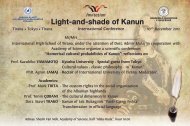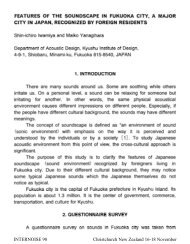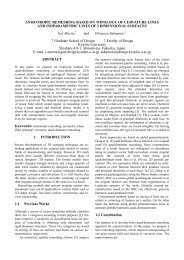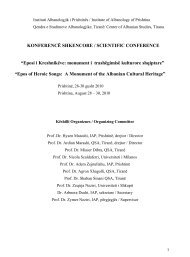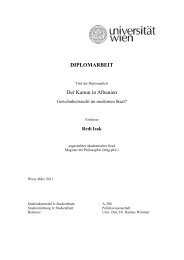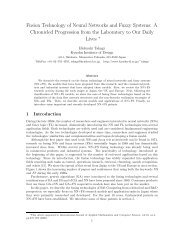Introduction of Soft Computing Techniques to Welfare Equipment
Introduction of Soft Computing Techniques to Welfare Equipment
Introduction of Soft Computing Techniques to Welfare Equipment
You also want an ePaper? Increase the reach of your titles
YUMPU automatically turns print PDFs into web optimized ePapers that Google loves.
<strong>Introduction</strong> <strong>of</strong> S<strong>of</strong>t <strong>Computing</strong> <strong>Techniques</strong> <strong>to</strong> <strong>Welfare</strong> Devices<br />
Hideyuki TAKAGI Shin'ichi KAMOHARA Takashi TAKEDA<br />
Kyushu Institute <strong>of</strong> Design<br />
Nagasaki Institute <strong>of</strong> Applied Science<br />
Shiobaru, Minami-ku, Fukuoka 815-8540 Japan<br />
E-mail: takagi@kyushu-id.ac.jp<br />
536 Aba, Nagasaki, 851-0193 Japan<br />
E-mail: kamo@cc.nias.ac.jp, takeda@csce.nias.ac.jp<br />
Abstract| This paper introduces our research<br />
on the use <strong>of</strong> s<strong>of</strong>t computing techniques<br />
for hearing impairment compensation<br />
and physical rehabilitation. Evolutionary<br />
computation (EC) is used for tting hearing<br />
aids based on an interactive EC and the<br />
user's preferences for sound. This technology<br />
allows hearing aid users <strong>to</strong> optimize their<br />
hearing aids in any acoustic environment with<br />
out pr<strong>of</strong>essional assistance. The virtual reality<br />
(VR) system for physical rehabilitation<br />
allows patients <strong>to</strong> train their muscles and re-<br />
exes according <strong>to</strong> the level <strong>of</strong> their physical<br />
conditioning. Finally, we discuss our approach<br />
<strong>to</strong> obtain new scientic through analyzing<br />
obtained hearing and VR characteristics<br />
by these two systems.<br />
1 <strong>Introduction</strong><br />
<strong>Welfare</strong> devices, such as hearing aids and rehabilitative<br />
equipment, have been mainly developed by<br />
medical engineers. Since the size <strong>of</strong> the commercial<br />
market is much smaller than that <strong>of</strong> the consumer<br />
electronics market, lower R&D costs have lead <strong>to</strong> an<br />
insucient introduction <strong>of</strong> computer science techniques<br />
in<strong>to</strong> the welfare industry. For example, the<br />
number <strong>of</strong> hearing aids sold in Japan is approximately<br />
400,000 or 410,000 per year.<br />
Some countries are becoming concerned about<br />
their aging population. For example, in Japan, it<br />
is predicted that the population <strong>of</strong> over 65 years old<br />
occupies 17% and 25% <strong>of</strong> all population in 2,000 and<br />
2,015, respectively, and the 20-year-old-and-younger<br />
segment decreases yearly [3]. This situation has an<br />
impact on social security issues such as medical insurance<br />
and pension systems. One eective solution<br />
is <strong>to</strong> increase the number <strong>of</strong> healthy people who support<br />
society by supporting social activity.<br />
Technology for this purpose is now desirable.<br />
Companies have come <strong>to</strong> pay attention <strong>to</strong> the growing<br />
market <strong>of</strong> an aging society, targeting welfare devices<br />
not only for people who are hearing-impaired<br />
0 Hideyuki Takagi, Shin'ichi Kamohara, and Takashi<br />
Takeda, \<strong>Introduction</strong> <strong>of</strong> S<strong>of</strong>t <strong>Computing</strong> <strong>Techniques</strong> <strong>to</strong> <strong>Welfare</strong><br />
<strong>Equipment</strong>," 1999 IEEE Midnight-Sun Workshop on S<strong>of</strong>t<br />
<strong>Computing</strong> Methods in Industrial Applications (SMCia'99),<br />
Kuusamo, Finland, pp.116{121 (June 16-18, 1999)<br />
at birth or who lost their hearing due <strong>to</strong> illness or accident,<br />
but also for those who are hearing-impaired<br />
due <strong>to</strong> aging. This change in market recognition has<br />
motivated the welfare industry <strong>to</strong> develop and apply<br />
recent technologies <strong>to</strong> welfare devices.<br />
In this paper, we introduce two <strong>of</strong> our on-going<br />
areas <strong>of</strong> research; one is the tting <strong>of</strong> hearing aids<br />
using an interactive EC (IEC) and the other is the<br />
use <strong>of</strong> physical rehabilitation equipment developed<br />
using VR.<br />
The interactive EC is a technology which optimizes<br />
systems based on human evaluation. Simply<br />
stated, it is an EC whose tness function is replaced<br />
by a human. It has been applied <strong>to</strong> several elds<br />
in the 1990's, including CG graphics, industrial design,<br />
music creation, speech processing, hearing aids,<br />
VR, data-mining, database retrieval, education, and<br />
games [7].<br />
Since the optimization searching surfaces <strong>of</strong> these<br />
tasks exist in the human mind, it is impossible <strong>to</strong><br />
calculate the gradient information <strong>of</strong> psychological<br />
space and apply gradient methods <strong>to</strong> them. Generally,<br />
optimization methods which require a numerical<br />
goal cannot be applied <strong>to</strong> these kinds <strong>of</strong> tasks.<br />
As the EC is a tness-based search, it is applicable<br />
<strong>to</strong>asearch<strong>of</strong>psychological space such as preference<br />
space when subjective evaluation is given as the tness<br />
values.<br />
VR is a technology that articially stimulates at<br />
least one <strong>of</strong> ve human senses. VR research is primarily<br />
visual and secondarily audi<strong>to</strong>ry. The amount<br />
<strong>of</strong> VR research on the sense <strong>of</strong> <strong>to</strong>uch or force is small,<br />
and VR research on the senses <strong>of</strong> smell or taste is<br />
very rare.<br />
VR sense <strong>of</strong> force, however, is the main research<br />
theme for physical rehabilitation. In the VR audio<br />
& visual environment, a person is only given VR<br />
vision and sound and does not communicate in this<br />
manner. Unlike the VR audio & visual environment,<br />
VR sense <strong>of</strong> force allows us <strong>to</strong> communicate with an<br />
agent or robot in a virtual environment using force;<br />
we can change the force according <strong>to</strong> the force from<br />
the VR environment and vice versa. This is one <strong>of</strong><br />
the indispensable functions for physical rehabilitation.
2 IEC-based Hearing Aids Fitting<br />
2.1 Conventional approach<br />
Conventional approaches <strong>to</strong> compensation for hearing<br />
impairment require previous measurement <strong>of</strong>the<br />
audi<strong>to</strong>ry characteristics <strong>of</strong> hearing aid users using<br />
pure <strong>to</strong>nes or band noise and try <strong>to</strong> adjust the differences<br />
between the hearing-impaired and persons<br />
<strong>of</strong> normal hearing.<br />
However, these approaches have several problems:<br />
(1) it is fundamentally impossible <strong>to</strong> compensate for<br />
hearing based on preference using the characteristics<br />
<strong>of</strong> audi<strong>to</strong>ry sense and perception measured by sound<br />
in non-daily life such as pure <strong>to</strong>nes or band noise,<br />
(2) it is dicult <strong>to</strong> t a hearing aid with mutual<br />
eects among audi<strong>to</strong>ry characteristics measured independently,<br />
and (3) it is doubtful that adjusting <strong>to</strong><br />
bring the characteristics <strong>of</strong> a hearing-impaired person<br />
close <strong>to</strong> those <strong>of</strong> a person with normal hearing<br />
will result in the best quality <strong>of</strong> compensated sounds.<br />
Essentially, nobody can know how other people<br />
hear, and conventional approaches limit our ability<br />
<strong>to</strong> t hearing aids for others (see Figure 1 left.)<br />
2.2 Proposed approach: IEC tting<br />
We propose an IEC tting method that is unlike<br />
conventional tting approaches [4, 8]. The proposed<br />
method optimizes the tting parameters <strong>of</strong> a hearing<br />
aid based on the end user's evaluation <strong>of</strong> heard sound<br />
(see Figure 1 right.) This approach can solve several<br />
diculties contained in the conventional approaches<br />
mentioned above.<br />
The key technology <strong>of</strong> the proposed method is an<br />
interactive EC. The IEC tting method does not<br />
require medical doc<strong>to</strong>rs or hearing aid engineers <strong>to</strong><br />
take preliminary measurements <strong>of</strong> the audi<strong>to</strong>ry characteristics<br />
<strong>of</strong> users and allows the users <strong>to</strong> t their<br />
hearing aids wherever and whenever they like using<br />
any sound source. Another advantage is that it<br />
does not depend on signal processing used in hearing<br />
aids. This allows several makers <strong>to</strong> adopt the<br />
method without signicant changes in their hearing<br />
aid systems.<br />
2.3 Experimental system<br />
2.3.1 Construction <strong>of</strong> a 3-D loudness space<br />
The proposed IEC tting is not a compensation<br />
method <strong>of</strong> hearing impairment but an optimizing<br />
method for the compensation method. This allows<br />
it <strong>to</strong> be applied <strong>to</strong> any hearing aid by anymaker. We<br />
propose construction <strong>of</strong> a 3-D loudness space whose<br />
axes consist <strong>of</strong> input SPL (sound pressure level), frequency,<br />
and amplication level <strong>to</strong> compensate for<br />
hearing impairment [4,5]. Our experimental hearing<br />
aid adopts this method.<br />
Since the dynamic range <strong>of</strong> hearing in hearingimpaired<br />
people is narrower than that <strong>of</strong> people with<br />
normal hearing, low SPL sound should be amplied,<br />
hearing aid<br />
Conventional<br />
EC<br />
hearing aid<br />
Proposed<br />
Figure 1: Conventional (left) and proposed (right)<br />
approaches for tting hearing aids.<br />
and high SPL sound should be attenuated. Furthermore,<br />
this compression characteristic depends<br />
on both frequency and the person. Conventional approaches<br />
require previous measurement <strong>of</strong> the characteristics<br />
<strong>of</strong> every octave band and ts the characteristics<br />
<strong>of</strong> a hearing aid <strong>to</strong> each person. Our proposed<br />
3-D loudness space is directly constructed by<br />
combining multiple 3-D Gaussian distribution functions<br />
without previous measurement (see Figure 2.)<br />
The interactive EC forms the best 3-D loudness<br />
space (which means the best compensation for hearing<br />
impairment) by nding the combination <strong>of</strong> the<br />
best parameters <strong>of</strong> Gaussian shapes.<br />
amplitude/attenuate level (dB)<br />
frequency (Hz)<br />
input sound pressure level (dB)<br />
Figure 2: Loudness space obtained by combining 3-<br />
D Gaussian functions. The interactive ECchanges<br />
the parameters <strong>of</strong> the functions based on hearing<br />
preferences. The shape <strong>of</strong> the loudness space is used<br />
as the characteristics <strong>of</strong> a tted hearing aid.<br />
2.3.2 GA conditions<br />
In our experiment, a 3-D loudness space is formed<br />
by ve 3-D Gaussian functions that have seven parameters<br />
such as mean coordinate, variances, height,<br />
etc. The seven parameters are 1 <strong>to</strong> 5 bits long, and<br />
the <strong>to</strong>tal parameter length <strong>of</strong> a Gaussian function is
36 bits [the length <strong>of</strong> a chromosome is 180 bits (=<br />
36 bits 2 5)].<br />
We adopt genetic algorithms (GA) for the interactive<br />
EC. Our GA conditions include the binary<br />
GA coding and the GA operations <strong>of</strong> roulette wheel<br />
selection, one-point crossover, elitist strategy, 80%<br />
crossover rate, and 2% mutation rate.<br />
2.4 Evaluation with speech<br />
2.4.1 Subjects<br />
Subjects consist <strong>of</strong> eight people with normal hearing<br />
with six kinds <strong>of</strong> simulated hearing-impaired characteristic<br />
lters [1] and three audi<strong>to</strong>ry nerve-impaired<br />
subjects|two with mild nerve impairment and one<br />
<strong>of</strong> moderate impairment.<br />
The speech source for the experimental evaluation<br />
consists <strong>of</strong> a male and female voice for all subjects<br />
and a male and female voice with noise from multiple<br />
speakers for hearing-impaired subjects and a <strong>to</strong>tal <strong>of</strong><br />
four kinds <strong>of</strong> speech.<br />
2.4.2 Evaluation with the index <strong>of</strong> ease <strong>of</strong> hearing<br />
Subjects compare the pair <strong>of</strong> speakers using: (1)<br />
loudness compensation based on proposed IEC tting<br />
and 3-D loudness space, (2) conventional loudness<br />
compensation based on previously measured<br />
loudness characteristics, and (3) no compensation.<br />
The comparison results are statistically tested by the<br />
sign test and are shown in Table 1.<br />
Table 1 clearly shows the superiority <strong>of</strong> the IEC<br />
tting method.<br />
Table 1: Subjective test results. Speech quality is compared<br />
using (1) the proposed IEC tting method, (2)<br />
conventional tting method, and (3) no compensation for<br />
hearing impairment. The numbers <strong>of</strong> \signicantly better"<br />
evaluations by the sign test with (p
2.5.2 Quality evaluation with dierent kinds <strong>of</strong><br />
music<br />
In this evaluation, the compensation characteristics<br />
obtained by the IEC tting method in section 2.5.1<br />
are applied <strong>to</strong> three dierent kinds <strong>of</strong> 4-second music<br />
sounds|saxophone solo, Latin female vocal, and<br />
rock style male vocal. Other experimental conditions<br />
are same with those in section 2.4.<br />
Table 4 shows the number <strong>of</strong> choices that are evaluated<br />
signicantly better with (p
allow rehabilitation patients <strong>to</strong> enjoy their rehabilitation<br />
as if playing a game.<br />
The pho<strong>to</strong>graph in Figure 4 is a picture <strong>of</strong> our<br />
pneumatically controlled arm wrestling robot [12, 2].<br />
The force and speed can be controlled according <strong>to</strong><br />
the patient's muscular condition. The facial expression<br />
<strong>of</strong> an opposing arm wrestler is shown <strong>to</strong> a rehabilitation<br />
patient through a head mount display.<br />
Figure 4 and that is used for dribbling a ball [10, 11].<br />
The patient watches the 3-D CG animation shown<br />
in Figure 6 that is synchronized <strong>to</strong> the force display,<br />
and the force display gives the user a sense <strong>of</strong> resistive<br />
force when his or her hand <strong>to</strong>uches the virtual<br />
ball.<br />
aluminum frame<br />
arm guide<br />
Interactive<br />
EC<br />
modifying rules<br />
subjective evaluation for VR<br />
Arm wrestling:<br />
human vs. robot<br />
fuzzy control<br />
rules for VR<br />
rubber skin<br />
exhaust hose<br />
intake hose<br />
controller<br />
Figure 5: A force display for ball dribbling.<br />
Figure 4: An arm wrestling robot and an interactive<br />
EC system <strong>to</strong> obtain VR fuzzy control rules.<br />
An important aspect <strong>of</strong> a VR arm wrestling robot<br />
is force control rules. Since a VR impression is provided<br />
by the natural exchange <strong>of</strong> force between a human<br />
and the arm wrestling robot, movement <strong>of</strong> the<br />
arm obtained from the calculation <strong>of</strong> physics equations<br />
is insucient for VR arm wrestling. Initial<br />
version <strong>of</strong> our system uses control rules obtained by<br />
a classication system and training data measured<br />
by actual humans arm wrestling [12, 2]. There are<br />
20,000 rules which may not be VR rules but rules <strong>to</strong><br />
resist the arm pressure <strong>of</strong> an opponent.<br />
Then, we are conducting research <strong>to</strong> obtain control<br />
rules for VR from these winner's rules. Au<strong>to</strong>matic<br />
design <strong>of</strong> a fuzzy system using GA and<br />
an interactive EC are being used for this rulemodication.<br />
First, we compiled the 20,000 classier<br />
rules in<strong>to</strong> a few fuzzy rules [2]. We used an<br />
au<strong>to</strong>matic design technique for fuzzy systems using<br />
GA. The few fuzzy rules obtained are equivalent<br />
<strong>to</strong> the 20,000 classier rules; both used <strong>to</strong> resist<br />
an opponent. Next, we are applying the interactive<br />
EC <strong>to</strong> modify the fuzzy rules based on a human<br />
arm wrestler's evaluation and obtaining rules for VR<br />
sense (see Figure 4). The human arm wrestler gives<br />
a higher score <strong>to</strong> the human-like movement anda<br />
lower score <strong>to</strong> the mechanical movement, and the<br />
EC modies the fuzzy control rules according <strong>to</strong> the<br />
human evaluation [2].<br />
3.4 Ball dribbling robot<br />
Figure 5 shows a pneumatically controlled force display<br />
that is attached <strong>to</strong> the grip <strong>of</strong> a robot arm in<br />
Figure 6: 3-D CG animation synchronizing with a<br />
force display for ball dribbling.<br />
Figure 7 shows the movement <strong>of</strong> a virtual ball and<br />
the hands <strong>of</strong> human subjects who can and one who<br />
cannot dribble a virtual ball. The overlapped parts<br />
<strong>of</strong> the two lines represent the time duration when<br />
the human hand is in contact with the virtual ball.<br />
The rehabilitation is conducted by changing the<br />
VR gravity and weight <strong>of</strong> ball according <strong>to</strong> a patient's<br />
condition and training progress.<br />
4 Acquisition <strong>of</strong> Scientific Knowledge<br />
4.1 Discovering new knowledge on hearing<br />
The characteristics <strong>of</strong> hearing aids tted by theIEC<br />
tting method are reected by the <strong>to</strong>tal characteristics<br />
from peripheral <strong>to</strong> central audi<strong>to</strong>ry. By analyzing<br />
these characteristics, we may obtain new knowledge<br />
on human hearing. So far, we have found that<br />
the best parameters <strong>of</strong> hearing aid for speech isnot<br />
the best for music sound, loudness function measured<br />
by pure <strong>to</strong>ne or band noise is dierent from
height <strong>of</strong> hand and a ball (m)<br />
height <strong>of</strong> hand and a ball (m)<br />
seconds<br />
seconds<br />
Figure 7: Ball trajec<strong>to</strong>ry and hand movement <strong>of</strong><br />
dribbling a ball in a virtual environment. Solid lines<br />
with and without circles indicate the movement <strong>of</strong><br />
a ball and hand, respectively. The upper and lower<br />
gures are represent the trajec<strong>to</strong>ries <strong>of</strong> a skilled subject<br />
and that <strong>of</strong> a beginner, respectively.<br />
that determined by speech and music, and so on<br />
[4, 6].<br />
4.2 Discovering the fac<strong>to</strong>r <strong>of</strong> VR<br />
One diculty is <strong>to</strong> design a controller whichprovides<br />
VR emotion. We apply an interactive EC<strong>to</strong>netune<br />
an arm wrestling controller because only a human<br />
can evaluate how realistically an arm wrestling<br />
robot can simulate a human opponent. As mentioned<br />
in section 3.3, we apply the interactive EC<br />
<strong>to</strong> modify fuzzy control rules from the winner's rules<br />
<strong>to</strong> the VR's rules. The dierence between the initial<br />
fuzzy control rules and the obtained fuzzy control<br />
rules is the main fac<strong>to</strong>r that causes VR sensation.<br />
By analyzing the dierences, we maybeable<strong>to</strong>analyze<br />
our perceived force VR.<br />
5 Conclusion<br />
We introduced an interactive EC-based hearing aid<br />
tting system and a VR physical rehabilitation system<br />
as applications <strong>of</strong> s<strong>of</strong>t computing technologies<br />
for welfare devices. Performance evaluation <strong>of</strong> the<br />
proposed IEC tting method using speech and musical<br />
sounds was also shown. We willevaluate the<br />
performance <strong>of</strong> a VR rehabilitation system in the<br />
near future. We also described dierent approaches<br />
<strong>to</strong> acquiring scientic knowledge from the obtained<br />
characteristics using these welfare devices and mentioned<br />
the possibility <strong>of</strong> using s<strong>of</strong>t computing technologies<br />
as research <strong>to</strong>ols.<br />
References<br />
[1] Duchnowski, P. and Zurek, P. M., \Villchur revisited:<br />
Another look at au<strong>to</strong>matic gain control<br />
simulation <strong>of</strong> recruiting hearing loss." vol.98, no.6,<br />
pp.3170{3181, 1995.<br />
[2] Kamohara, S., Takagi, H., and Takeda, T., \Control<br />
rule acquisition for an arm wrestling robot," IEEE<br />
Int'l Conf. on System, Man, Cybernetics (SMC'97),<br />
Vol.5, pp.4227{4231, Orlando, Florida, USA, (Oct.,<br />
1997)<br />
[3] Web page <strong>of</strong> National Institute <strong>of</strong> Population and<br />
Social Security Research,<br />
URL: http://www.ipss.go.jp/index-e.html.<br />
[4] Ohsaki, M., \A study on the compensation for<br />
hearing impairment based on evolutionary computation,"<br />
Doc<strong>to</strong>ral Dissertation, Kyushu Institute <strong>of</strong><br />
Design (Dec., 1998) (in Japanese).<br />
[5] Ohsaki, M., Tsumura, T., Takagi, H., and Shimada,<br />
M., \Evaluation <strong>of</strong> IEC tting system on<br />
speech hearing," Annual Meeting <strong>of</strong> Acoustic Society<br />
<strong>of</strong> Japan 1-2-19, pp.361{362 (March, 1999) (in<br />
Japanese).<br />
[6] Ohsaki, M., Tsumura, T., Takagi, H., and Shimada,<br />
M., \Application <strong>of</strong> IEC tting system <strong>to</strong><br />
music hearing," Annual Meeting <strong>of</strong> Acoustic Society<br />
<strong>of</strong> Japan 1-2-20, pp.363{364 (March, 1999) (in<br />
Japanese).<br />
[7] Takagi, H., \Interactive evolutionary computation,<br />
{ cooperation <strong>of</strong> computational intelligence and human<br />
KANSEI {," 5th Int'l Conf. on S<strong>of</strong>t <strong>Computing</strong><br />
and Information/Intelligent systems (IIZUKA'98),<br />
pp.41{50, Iizuka, Fukuoka, Japan, World Scientic<br />
(Oct., 1998).<br />
[8] Takagi, H. and Ohsaki, M., \Au<strong>to</strong>matic optimization<br />
<strong>of</strong> hearing aids based on how user hears," Annual<br />
Meeting <strong>of</strong> Acoustic Society <strong>of</strong> Japan, 1-2-18,<br />
pp.359{360 (March, 1999) (in Japanese).<br />
[9] Takeda, T. \Development <strong>of</strong> a system <strong>of</strong> upper extremity<br />
exercise and muscular measurement using<br />
virtual reality," Bionism, vol.12, pp.265{279 (1994)<br />
(in Japanese).<br />
[10] Takeda, T. and Tsutsui, Y., \On the computer simulation<br />
<strong>of</strong> ball dribble in the virtual environment,'<br />
' 6th Int'l Conf. on Human-Computer Interactions,<br />
Tokyo, Japan, vol.a, pp.473{478 (July, 1995)<br />
[11] Takeda, T. and Tsutsui, Y., \Construction <strong>of</strong> virtual<br />
environment with force display for ball dribbling,"<br />
J. <strong>of</strong> the Inst. <strong>of</strong> Television Eng. <strong>of</strong> Japan,<br />
vol.49, no.10, pp.1339{1346 (1995) (in Japanese).<br />
[12] Takeda, T. and Kamohara, S., \Construction <strong>of</strong><br />
VR system <strong>to</strong> the arm wrestling with virtual person,"<br />
Trans. <strong>of</strong> the Inst. <strong>of</strong> Electr., Infor. and Commun.<br />
Eng. A, vol.J79-A, no.2, pp.489{497 (1996)<br />
(in Japanese).



